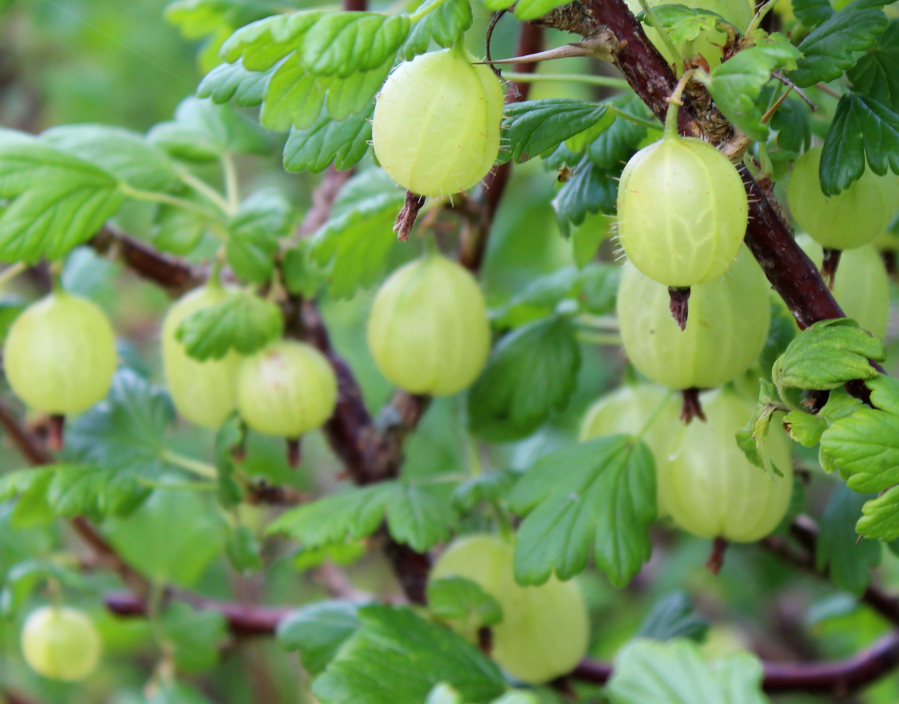The gooseberry is native to Europe, northwest Africa, Asia and parts of North America. There are now around 2,500 cultivars and two main gooseberry types: American and European, which are larger and said to be tastier. They’re from the same family as currants.
Gooseberries come in many textural finishes: smooth, fuzzy, spiny, opaque and translucent, always with a taut skin and firm flesh. Sizes and flavor may vary: they may be as big as a cherry tomato or as tiny as a blueberry. This berry comes in varying shades of yellow, green, red or black. They can be round, oval, pear-shaped or elongated. Flavors can be tart or slightly sweet, though always measuring high in acid.
This little berry is exceptionally nutritious. Gooseberries contain a healthy dose of vitamin C — nearly 20 times the C in oranges. It is important to note that the cooking process does not deplete the vitamin C. In addition this berry is high in fiber and omega 3 fatty acids and is found to have beneficial effects against cancer, aging and neurological diseases.
In the Pacific Northwest, gooseberries are in season from May to August, and they are at their peak during July. Look for firm, dry berries that are rich in color; avoid berries that are excessively soft, shriveled or leaking juice. If not used immediately, store them in the refrigerator where they keep fresh for up to two weeks. The berries will turn pinker and softer during refrigeration. When they turn purple they should be used as soon as possible.
Fresh berries can be eaten raw as a tasty snack, or cooked and used in cakes, pies, as a topping for ice cream and custard or in savory sauces.
The tartness of these berries makes them a viable chutney ingredient; serve a sweet-tart chutney alongside meat and rice for a sweet, spicy and savory combination. Gooseberry chutney is also a wonderful addition to a cheese platter.
Gooseberries are most commonly used for jams and jellies. The sweet-and-tart berry creates a delicious single fruit jam, and is also commonly combined with other seasonal fruits to create such varieties as gooseberry currant jam and strawberry gooseberry jam.
This versatile fruit can be dehydrated and eaten fresh or used in recipes in place of dried cranberry or raisin. Pickled gooseberries are a tangy accompaniment to meat dishes and even cocktails. In a saucepan, combine 1 cup sugar, 1 cup water, 1/4 cup vinegar, and spices of your choice (think peppercorns, cloves, mustard seeds, ginger) and bring to a boil. Add 1 lb. of trimmed gooseberries and simmer for 1 minute. Pour into a mason jar, making sure syrup covers the berries, cap and let cool. Stored in the refrigerator, pickled gooseberries will last for a few months.
During the 1800s, there was a “gooseberry craze” that began in England and spread to America. At its height, gooseberry clubs began to form, gardeners began cultivating new varieties and serious competitions were held to determine who grew the finest gooseberries. Though the fad waned in the early 1900s, “Gooseberry Fool” remains a favorite dessert in British families. For an easy “Fool,” simmer sweetened gooseberries until soft, then mash and swirl into whipped cream, yogurt or vanilla custard.
Judi Seifert is a Clark County WSU Extension master food preserver. For additional recipes, food preservation and food safety information visit http://ext100.wsu.edu/clark/?p=1134. Have questions? Call MFP Helpline: 360-397-6060 ext. 5366, or join Facebook discussion group “WSU Home Food Preservers – Clark County.”



